ASUS G74SX: Noteworthy Updates to ASUS' G7 Series
by Jarred Walton on October 6, 2011 12:00 AM ESTSystem Temperatures and Noise Levels
One area where I’ve praised the ASUS G73 in the past is their thermals and noise levels. The G74SX continues that reputation, providing an extremely quiet notebook even during lengthy gaming sessions. Idle noise levels fail to register above the ~30dB noise floor of my testing equipment and environment, and under maximum load the G74SX still only hits 37.3dB. Of course, noise is only half the equation—is ASUS just running their fans at low RPMs to keep things quiet while letting the internal components roast? Here’s a chart showing maximum temperatures as reported by HWMonitor after several hours of running high load tasks (Cinebench, x264 encoding, gaming, 3DMark looping, and even 3DMark looping while Cinebench renders in the background).
Compared to the noise created by Clevo gaming notebooks and other offerings like MSI’s GT680R, the ASUS G7 series delivers the goods in cooling and keeping quiet. In our stress testing, the CPU maxed out at a comfortable 76C, while the GTX 560M laughs as it fans itself lightly with a 65C core temperature. That makes the CPU temperatures roughly the same as the G73, while GPU temperatures have dropped 10C—apparently the reworking of the internals paid off handsomely.
I do have a concern over whether the G74SX can handle extreme environments—like say a soldier wants to pack one of these over to the Middle East during the summer months. To see if the fan speeds normally experienced are the maximum ASUS supports or if the system just isn’t getting hot enough to ramp up the RPMs, I put my hand over the rear vent while running 3DMark06. Naturally, temperatures started to climb, but unfortunately I can’t say the same for the fan RPMs. Noise levels remained consistent throughout the approximately 10 minute test run, and the GPU did manage to get up to 75C according to HWMonitor. That’s still 8C below what Dustin measured on the Alienware M18x, but it was painfully hot on my arm/hand. (Honestly, I’m surprised the GPU and CPU didn’t get any hotter!) The final score also dropped slightly (to 15241), but I’m not sure if that was a decrease caused by heat or if the new (beta) drivers are to blame.
While the above scenario may not be a fair test, I do wish ASUS had at least one higher fan speed available, and with a maximum load of Cinebench + 3DMark06 there did appear to be some throttling going on—again, though, only when I covered the exhaust vent, which isn’t something I’d recommend doing. The lack of a higher (and noisier) fan speed may also be why ASUS limits the G74SX to the GTX 560M. The GTX 570M and GTX 580M would likely need better cooling, and ASUS may not be willing to sacrifice noise levels in order to support such GPUs.
Update: A reader pointed out a potential CPU throttling issue in the comments, and I was able to replicate the throttling. The throttling so far required the use of Furmark along with a heavily threaded CPU workload, at which point the CPU clock drops to 800MHz and stays there until Furmark is halted (or the CPU load is removed). The temperatures are not a problem, and without using Furmark I have not been able to cause CPU throttling, but the potential is at least there. If anyone has other specific workloads not involving Furmarm (or a similar utility, e.g. MSI Kombustor), please let me know and I will investigate further.
Still a Good LCD
The G73 notebook had a good LCD, with a high contrast and reasonable color. My one complaint was that even at maximum intensity, the backlight wasn’t as bright as I would like. With the G74SX, ASUS appears to have taken that criticism to heart, as the maximum brightness is nearly double that of its predecessor.
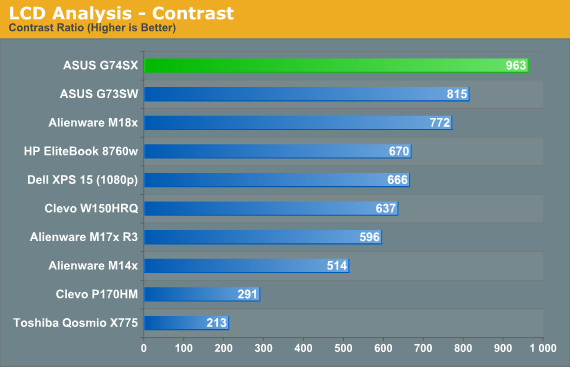
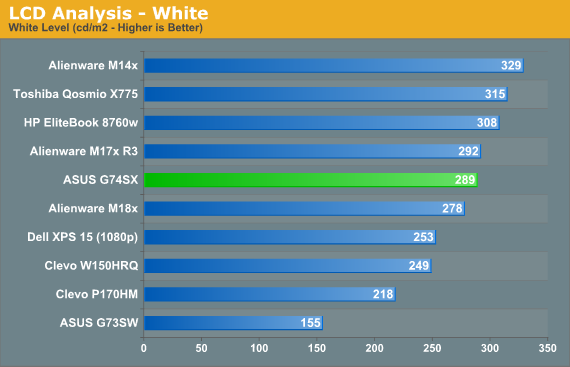
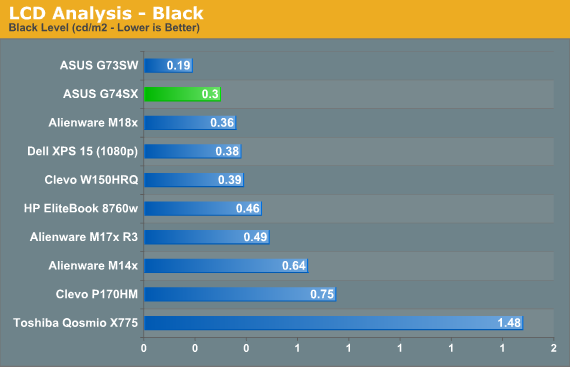
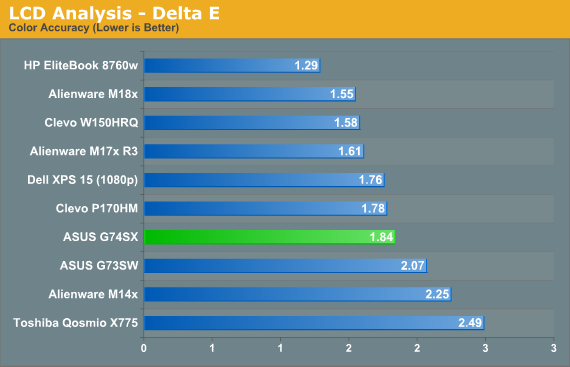
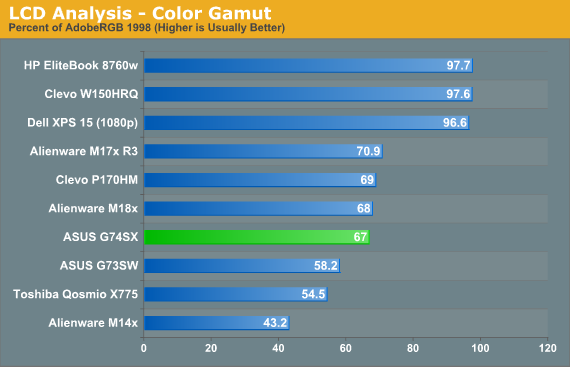
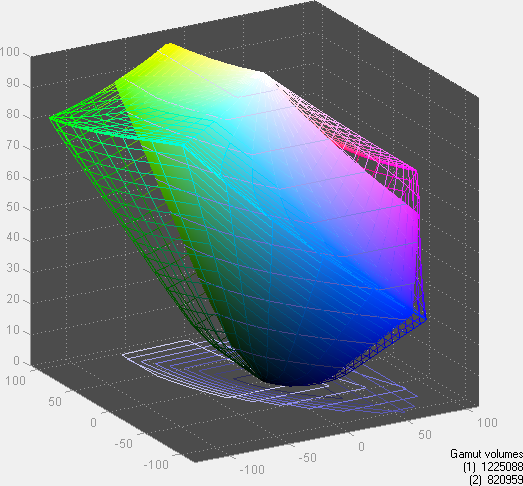
Contrast is excellent at nearly 1000:1, and the maximum white level of 289 nits is a big step up from the ~150 nits of the G73 series. Given the change in characteristics, it’s no surprise that the LCD panel used in the G74SX is different this round, coming from Chimei Innolux (instead of HannStar). The model is N173HGE-L21, and it appears that our contrast ratio result is better than the advertised 500:1. Backlight intensity is up, and we also note that color gamut is up, with a slight (not generally noticeable) improvement in color accuracy as well. Without calibration, the panel has a decidedly bluish cast, but that’s common among LED backlit panels. Overall, I definitely appreciate the changes made to the LCD panel; the previous version was good, but the new version matches or improves on it in virtually every way.
We’re still dealing with a TN panel, so viewing angles aren’t perfect, but they’re about as good as you can expect from the technology. I still wish the notebook people would start using IPS panels in laptops—they’re putting them in $400 tablets after all, so it can’t be that hard to fit one into the budget of a $1500+ notebook, can it? Then again, supply and demand create a self-perpetuating cycle, so as demand dries up so does supply, resulting in higher prices for the remaining supply, which segues back into lowered demand, etc. I’d love to see that trend reverse and go the other way.


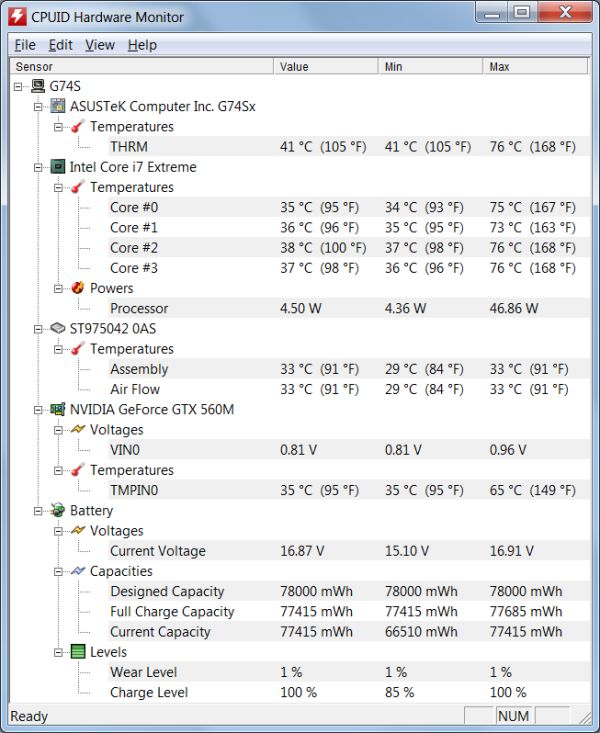













44 Comments
View All Comments
Siorus - Tuesday, October 11, 2011 - link
Unfortunately it doesn't look like I'm going to have time to play around with either system at work anytime soon, so all I can do is relay the information I found when I was trying to deal with it a few months ago.GTA4, GRID, Starcraft 2, WoW and Left 4 Dead 2 are all affected, according to this thread on notebookreview: http://forum.notebookreview.com/asus-gaming-notebo...
And I understand your position on Furmark; there's no arguing that it's a "power virus" so to speak. That said, my personal opinion is that the power supply and cooling systems on these graphics cards should be designed with the absolute worst-case scenario in mind. Limiting board power to keep the card from smoking itself is ridiculous; it's taking the cheap way out rather than beefing up the power supply and the heatsink.
At the risk of going off on a rant (I'll try to keep it short), I see it as symptomatic of a cultural shift; it's evident in plenty of other consumer devices. For instance, I've got a Pioneer SX-1980 stereo receiver. Made in 1978. Linear power supply; the transformer is a toroid around the size of a 50 pack of DVDs; the filter caps are the size of beer cans. It weighs almost 100lbs, and it's rated for 275 watts per channel into 8 ohms. That's continuous power, with both channels driven. The most powerful stereo receiver Pioneer ever made. It will happily put out its rated 550w, 24hrs a day, 7 days a week, from now until the caps dry out or whatever. Almost all modern multichannel receivers will not do that; they are often rated with only 1 channel driven, and "continuous" power quite frequently means for a duration of a handful of seconds or less. A lot of people would consider the SX-1980 to be "overbuilt"; it's not-it's just built to do what the box says it will do, which has become something of an alien concept.
But nobody cares because they don't want to spend any money. People would rather pay $200 for a receiver-or a graphics card-than $300 or $400 for one that's built properly. *shrug*
chinedooo - Saturday, October 8, 2011 - link
ATI does graphics switching so much better than Nvidia. With my dv6t i have the option of using dynamic switching like optimus which switches automatically based on the application, or fixed switching which i switch manually, and it also switches when the laptop is running off battery.JarredWalton - Saturday, October 8, 2011 - link
And the flickering on manual switching is awesome, plus the regular driver updates from AMD... wait, you don't those, do you? I did a whole article on comparing Optimus and AMD Dynamic Switchable; it's not even a close competition:http://www.anandtech.com/show/4839/
darklu - Sunday, October 9, 2011 - link
where is the excellent gt780r by msi in your test?the msi is better than g74 because he had an 570m ^^